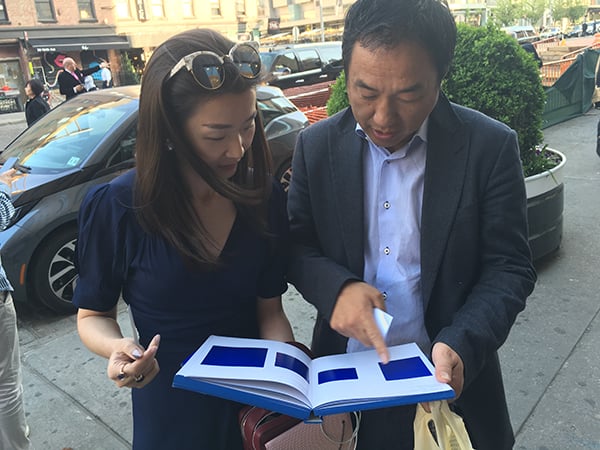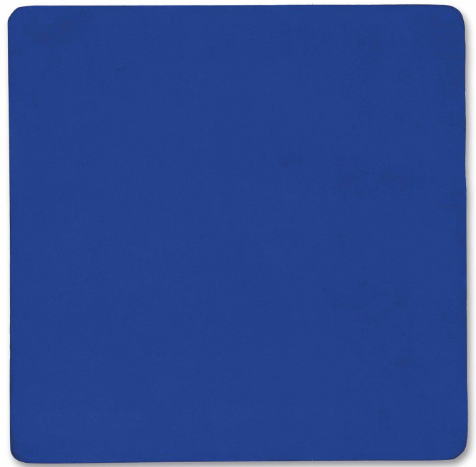Auctions
Confessions of a First Time Art Collector: Edward Zeng
What does Steve Jobs have to do with it?

What does Steve Jobs have to do with it?

Rozalia Jovanovic

I met with collector Edward (Qiang) Zeng on May 12, two days after he made a splash with his purchase of Yves Klein’s Untitled Blue Monochrome (IKB 108), at Christie’s postwar and contemporary art evening sale. He picked up the painting for $3.3 million (just above its $3 million low estimate). But more noteworthy than the price was the fact that it was the first work of art he had ever bought.
Zeng is the Founder and CEO of Sparkice, Inc., an eCommerce company that specializes in financing China-based companies for reverse take-overs on North American stock exchanges. He’s also the founding partner of China Bridge Capital. In 1998, Zeng was called one of China’s pre-eminent entrepreneurs by TIME magazine and, that same year, he was named a Future Leader for Tomorrow by the World Economic Forum.
We regrouped at Soho House late that afternoon, jumped in a car, and traveled up to Christie’s for the Impressionist & modern art sale. Our talk was done with the help of Vanessa Guo, a director at Hauser & Wirth who focuses on Asia and who’s also Zeng’s art advisor. Here’s what we said.

Sam Francis, Red No. 1.
Image: Courtesy of Christie’s
Why did you choose to start your collection with Yves Klein’s painting IKB 108?
I had not planned for that. It was supposed to be another one. Called Red No. 1. I had planned for the Sam Francis. So this one come up before that. And all of a sudden, it was like a beautiful girl swimming out from the ocean. Very beautiful. It touched my heart. I said, “Let’s bid.”
My assistant said, “We had not planned for that. We have not done any research for that.” I said, “I like it. Let’s do it.”
We thought it would be several rounds of bidding. Suddenly it stopped. Maybe the auctioneer wanted the newcomer to get it. We got it for a very low price.
You just started collecting. Do you like it?
I like it I’m very excited. Even making money, for business, I’m not as excited as I am with this.
Are you already thinking about what you might want to collect next?
I think for Yves Kleins, if I could buy IKB 1. I know it’s like $10 million but it’s my target. [Aside: I was curious and did some research in the artnet Price Database. The work Zeng was referring to, IKB 1 (1960), was sold in 2008 at Sotheby’s New York for $17.4 million. (It was estimated to sell for $5 million – $7 million.)] Because this artist, he has a philosophy. In Chinese philosophy, you have to be empty to get something. If you have a teapot, and you leave old water in overnight, you’ll never drink fresh water. Empty it first. Then you drink fresh tea. In our industry one of our heroes is Steve Jobs. He would always go to India to try to get some tips from Zen philosophy. Once he learned more about empty, he developed an ecosystem, IOS…. When you become empty and let other people share with you then you become developers of the ecosystem. So it’s very important to become empty to absorb new ideas. This is a philosophy in our industry. From this piece of art, I do see a lot of things like this. I see the blue, the empty…. It’s Simple. Simple is beautiful.
Do you know who owns IKB 1?
No. Before I came to New York, a friend of mine shared the stories of three artists with me. One is Sam Francis. Another is Monet. He said, in France, in [Yves Klein’s] memory, all the buildings including the Eiffel tower are turned Yves Klein blue. This story touched my heart. Why does the whole nation give this guy an honor. After I got this piece, I did some research and I found out he has done a lot of things. Yves klein was a destructive artist. His famous artwork, The Void – Steve Jobs said if you want to be successful you have to kill 1000 creative ideas every day, just by focusing.

Yves Klein, Untitled Blue Monochrome (IKB 108).
Image: Courtesy of Christie’s
Are you interested in buying anything more tonight?
Not this time, but we have already set up an art fund that is in the late stage process. So we’ll have some more information soon.
Who’s investing in the fund?
Global partners. And Chinese entrepreneurs who have a similar background.
Where will you put the work?
It’s still in the Christie’s warehouse. I have no idea.
Vanessa Guo: [Zeng] was talking about bringing Yves Klein to China, maybe doing a retrospective. He had such a short creative period and no one’s gotten to know him.
If you could have one trophy piece now, what would it be?
IKB 1. This one gives you not only art. It leads you somewhere. It’s an intermediary to help your imagination, creativeness, to open your mind. It’s like a button going to another world. If you have art like a Picasso or a Monet, it’s art. You can’t go beyond the wall. I’m thinking of changing my company logo now, to blue.
You started big—buying a work for $3 million. Some collectors might have started on a smaller scale.
That night, the Basquiat sold for $57 million, so my piece was probably one of the lowest. I think for this artist, his works are still undervalued. European people understand him…. If he was born in America… if his actions were recorded…in America, not in Europe, his price would be five times or triple what it is now. People are still thinking Chinese like to pay $170 million to buy a Modigliani. But now different people have different tastes. Even the top pictures, if I could choose from those, I’d still buy the Yves Klein.
How did you like being at the auction house?
It’s very exciting. Actually my first job, as a student, was as an art handler. So [the auction houses] gave me the first money I ever got in my life. I got a $1 tip. I thought the woman gave me $100. It was only $1. That was after working for five hours. After I got only $1, I said forget it. That was 20 years ago in 1996.
What about the Basquiat or the Koons. Neither of those interested you?
I like the size, but…. My background is in mathematics, so I need something simple, pure.
I almost bought the Lucio Fontana. The red color with the slashes—it means the revolution starts to burn out the history. But the blue is the creation of the future…. [Richard Prince’s] Runaway Nurse is very good. But I don’t have the money.